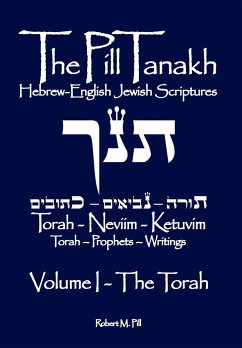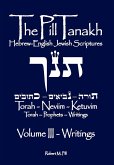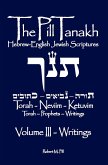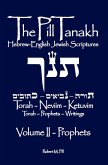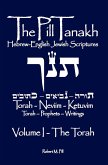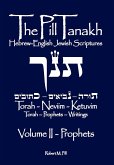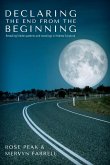The Hebrew-English Jewish Scriptures, Volume 1 - The Torah. This book comprises the first five books of the Jewish Scriptures, otherwise known as The Torah, The Five Books of Moses, and The Chumash. What makes The Pill Tanakh different? The following are some examples. 1) The Hebrew and the English are side-by-side, on facing pages, with matching verses; there is no run-over of the more verbose English to another page! 2) Each new book starts with an image from the photo-facsimile Leningrad Codex on the page that the first verse of the book begins. Underneath each page image, the column and position of the first verse of the book is provided, and the page file number from the Leningrad Codex pdf is provided. 3) For this edition, I have altered both the Hebrew and English especially to conform to the actual Leningrad Codex (circa year 1009), most notably in the Ten Commandments of Exodus 20 and Deuteronomy 5. 4) I set the Hebrew numbering, represented by Hebrew letters, to follow a natural rendering for numbers 15 and 16, which rabbis insist must be obfuscated to NOT reflect the Divine Name (YHVH). I use yud-he for 15 and yud-vav for 16 instead of tet-vav and tet-zayin as per 'rabbinic superstition!' 5) Additionally, I have altered some English verses to better represent the Hebrew text in several places. As an example, I changed the over 5,000 instances where the title 'the Lord God' appears, replacing it with 'Yehovah', the transliteration of the Hebrew. 6) In the margin of a line in the actual Leningrad Codex, there are words added that rabbis refer to as 'Qere' (what is to be read). These words were intended to replace a matching word in the written text, known as 'Ketiv' (what is written). Other Jewish publications force the reading of the 'Qere' in lieu of the 'Ketiv,' obscuring the originally written text; some versions place the 'Ketiv' in brackets while others place it in the margin outside the line! In The Pill Tanakh, I relegate those 1,110 'Qere additions' to small footnote notations in the Hebrew text, so that the reading is natural just as the Masoretic scribes intended. Moreover, I have found few instances where the 'Qere' is actually correct, but there are many instances that are blatantly wrong! Again, this is Volume 1 - The Torah, part of a three volume set of Torah, Prophets and Writings, which make up the entire Jewish Scriptures.
Hinweis: Dieser Artikel kann nur an eine deutsche Lieferadresse ausgeliefert werden.
Hinweis: Dieser Artikel kann nur an eine deutsche Lieferadresse ausgeliefert werden.

